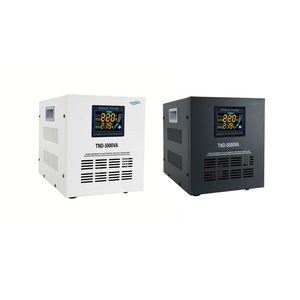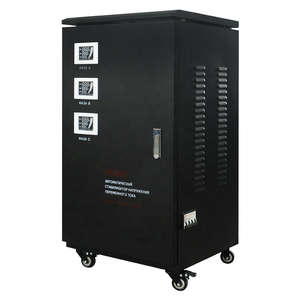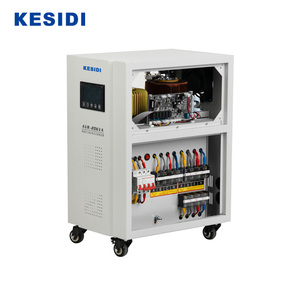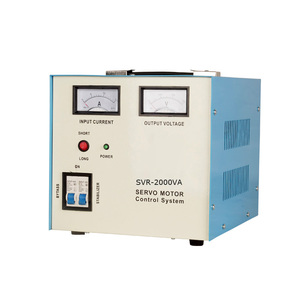Linear Servo Voltage Stabilizer


















 1/19
1/19






 1/37
1/37








 1/1
1/1





 1/12
1/12






 1/20
1/20








 1/22
1/22








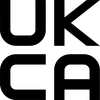

 1/17
1/17











About linear servo voltage stabilizer
Where to Find Linear Servo Voltage Stabilizer Suppliers?
China remains the central hub for linear servo voltage stabilizer manufacturing, with key production clusters in Guangdong and Zhejiang provinces. These regions host vertically integrated supply chains that combine precision coil winding, transformer core fabrication, and electronic control systems assembly under one ecosystem. Dongguan and Huizhou in Guangdong are known for high-volume production of compact single-phase units, while Zhejiang-based manufacturers specialize in industrial-grade three-phase models with capacities exceeding 100KVA.
The concentration of component suppliers—ranging from copper windings to servo motors and PCB controllers—within a 50km radius enables rapid prototyping and scalable production. This localization reduces lead times by up to 25% compared to offshore alternatives and supports cost efficiencies, with typical unit production costs 18–30% below Western market averages. Buyers benefit from flexible MOQs, ranging from 1 set for high-power models to 5–50 units for consumer-grade stabilizers, facilitating both bulk procurement and niche deployments.
How to Choose Linear Servo Voltage Stabilizer Suppliers?
Selecting reliable suppliers requires adherence to structured evaluation criteria:
Technical Compliance & Design Capability
Verify that suppliers design stabilizers meeting IEC 61000-4-30 power quality standards for voltage regulation accuracy (±1–3%). For export markets, confirm CE or RoHS compliance where applicable. Assess product range diversity—reputable manufacturers offer both single-phase (1KVA–50KVA) and three-phase (30KVA–300KVA) configurations with input voltage ranges covering 160–250V or 304–456V across phases.
Production Infrastructure Assessment
Evaluate operational scale through measurable indicators:
- Facility size supporting dedicated testing bays and aging chambers
- In-house transformer winding and PCB integration lines
- On-site load testing capacity using resistive-inductive test benches
Cross-reference supplier-reported data with on-time delivery performance; a rate ≥94% indicates robust production planning and inventory control.
Transaction Risk Mitigation
Prioritize suppliers offering verifiable transaction histories, including documented reorder rates and response times. Utilize secure payment mechanisms such as escrow services until post-delivery performance validation. Conduct sample testing under fluctuating load conditions (75%, 100%, 110% rated capacity) to verify stabilization response time (<10ms) and output voltage stability.
What Are the Best Linear Servo Voltage Stabilizer Suppliers?
| Company Name | Location | Main Products | Online Revenue | On-Time Delivery | Avg. Response | Reorder Rate | MOQ Range | Price Range (USD) |
|---|---|---|---|---|---|---|---|---|
| Dongguan Kunmai Power Supply Co., Ltd. | Guangdong, CN | Voltage Regulators/Stabilizers, Transformers, Industrial Power Supplies | US $8,000+ | 100% | ≤1h | <15% | 1–2 pcs | $120–$4,000 |
| Zhejiang Kaiyi Electric Co., Ltd. | Zhejiang, CN | Voltage Regulators/Stabilizers, ATS, Circuit Breakers | US $30,000+ | 100% | ≤1h | 21% | 1–5 sets | $35–$1,988 |
| Huizhou Yinghua Electronic Co., Ltd. | Guangdong, CN | Voltage Regulators/Stabilizers, Inverters, Solar Charge Controllers | US $80+ | 100% | ≤12h | <15% | 1–50 units | $50–$69 |
| Jinan Jintong Import And Export Co., Ltd. | Shandong, CN | Voltage Regulators/Stabilizers, Transformers, Laser Equipment Parts | US $20,000+ | 94% | ≤1h | 20% | 1 piece/set | $75–$190 |
| Dernfu Electronic (Dongguan) Co., Ltd. | Guangdong, CN | Transformers, LV/MV Equipment, Voltage Protection Devices | Not specified | 100% | ≤14h | Not available | 10–2000 units | $14–$250 |
Performance Analysis
Dongguan Kunmai and Zhejiang Kaiyi demonstrate strong technical breadth, offering high-capacity three-phase stabilizers (up to 300KVA) suitable for industrial applications. Zhejiang Kaiyi stands out with a 21% reorder rate and competitive pricing on mid-range models, indicating customer satisfaction in commercial installations. Jinan Jintong offers aggressive pricing on standard single-phase units but reports a lower on-time delivery rate (94%), suggesting potential logistical constraints during peak demand. Huizhou Yinghua focuses on entry-level stabilizers with low per-unit costs but targets higher MOQs for certain listings, aligning with OEM or retail distribution strategies. Dernfu, while showing minimal online revenue disclosure, provides ultra-low-cost protection modules ideal for integration into larger electrical systems.
FAQs
How to verify linear servo voltage stabilizer supplier reliability?
Confirm consistency between declared certifications (e.g., ISO 9001, CE) and official audit records. Request factory inspection reports detailing quality control procedures, including dielectric strength testing, thermal rise tests, and long-duration burn-in cycles. Analyze buyer feedback focusing on real-world performance under unstable grid conditions.
What is the typical lead time for custom stabilizers?
Standard models ship within 15–25 days after order confirmation. Custom designs requiring unique voltage ranges, enclosure types (IP20/IP54), or communication interfaces (RS485/Modbus) typically require 30–45 days, including prototype approval.
Can suppliers accommodate OEM branding and packaging?
Yes, most suppliers listed support OEM labeling, custom nameplates, and branded packaging. Minimum thresholds usually start at 50 units for private labeling, with additional fees for graphic design and tooling if required.
Do linear servo stabilizers require regular maintenance?
Servo-driven models necessitate periodic cleaning of carbon brushes and motor commutators, recommended every 6–12 months in dusty environments. High-quality units incorporate brushless servo mechanisms to minimize maintenance needs while enhancing longevity.
How to assess stabilization accuracy before purchase?
Request test reports showing output voltage deviation under ±20% input variation. Benchmark against industry standards: premium-grade stabilizers maintain ±1–2% regulation, while general-purpose units may allow ±3–5%. On-site sampling with variable autotransformers and data-logging voltmeters provides empirical validation.










